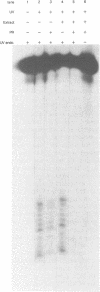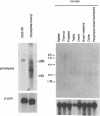Abstract
Photoreactivating enzyme, DNA photolyase, reduces lethal, mutagenic and carcinogenic effects of ultraviolet light (UV) by catalyzing near UV or visible light-dependent repair of cyclobutane pyrimidine dimers (CPDs) in DNA. The enzyme activity has been detected in a wide variety of organisms ranging from bacteria to nonplacental mammals. However, the evidence for photoreactivation in placental mammals, including humans, is controversial. As a first step to identify the presence and activity of the gene in mammalian species, we isolated a cDNA clone of this gene from a marsupial, the South American opossum Monodelphis domestica. Photolyase activity was expressed in Escherichia coli from the cDNA which is predicted to encode a polypeptide of 470 amino acid residues. The deduced amino acid sequence of this protein is strikingly similar to those of photolyases from two metazoans; the opossum photolyase shares 59% and 63% sequence identity with the Drosophila melanogaster and goldfish Carassius auratus enzymes, respectively. However, no closely related nucleotide sequence was detected in higher mammals and a homologous transcript was undetectable in a number of human tissues. These results strongly suggest that humans, as well as other placental mammals, lack the photolyase gene.
Full text
PDF





Images in this article
Selected References
These references are in PubMed. This may not be the complete list of references from this article.
- Brash D. E. UV mutagenic photoproducts in Escherichia coli and human cells: a molecular genetics perspective on human skin cancer. Photochem Photobiol. 1988 Jul;48(1):59–66. doi: 10.1111/j.1751-1097.1988.tb02786.x. [DOI] [PubMed] [Google Scholar]
- Cook J. S., McGrath J. R. Photoreactivating-enzyme activity in metazoa. Proc Natl Acad Sci U S A. 1967 Oct;58(4):1359–1365. doi: 10.1073/pnas.58.4.1359. [DOI] [PMC free article] [PubMed] [Google Scholar]
- Cook J. S. Photoreactivation in animal cells. Photophysiology. 1970;5:191–233. [PubMed] [Google Scholar]
- Cook J. S., Regan J. D. Photoreactivation and photoreactivating enzyme activity in an order of mammals (Marsupialia). Nature. 1969 Sep 6;223(5210):1066–1067. doi: 10.1038/2231066a0. [DOI] [PubMed] [Google Scholar]
- Frohman M. A., Dush M. K., Martin G. R. Rapid production of full-length cDNAs from rare transcripts: amplification using a single gene-specific oligonucleotide primer. Proc Natl Acad Sci U S A. 1988 Dec;85(23):8998–9002. doi: 10.1073/pnas.85.23.8998. [DOI] [PMC free article] [PubMed] [Google Scholar]
- Ikenaga M., Tsujimura T., Chang H. R., Fujio C., Zhang Y. P., Ishizaki K., Kataoka H., Shima A. Comparative analysis of O6-methylguanine methyltransferase activity and cellular sensitivity to alkylating agents in cell strains derived from a variety of animal species. Mutat Res. 1987 Sep;184(2):161–168. doi: 10.1016/0167-8817(87)90073-3. [DOI] [PubMed] [Google Scholar]
- Ley R. D., Applegate L. A., Fry R. J., Sanchez A. B. Photoreactivation of ultraviolet radiation-induced skin and eye tumors of Monodelphis domestica. Cancer Res. 1991 Dec 15;51(24):6539–6542. [PubMed] [Google Scholar]
- Li Y. F., Kim S. T., Sancar A. Evidence for lack of DNA photoreactivating enzyme in humans. Proc Natl Acad Sci U S A. 1993 May 15;90(10):4389–4393. doi: 10.1073/pnas.90.10.4389. [DOI] [PMC free article] [PubMed] [Google Scholar]
- Ogut S. E., D'Ambrosio S. M., Samuel M., Sutherland B. M. DNA photoreactivating enzyme from human tissues. J Photochem Photobiol B. 1989 Oct;4(1):47–56. doi: 10.1016/1011-1344(89)80101-0. [DOI] [PubMed] [Google Scholar]
- Sabourin C. L., Ley R. D. Isolation and characterization of a marsupial DNA photolyase. Photochem Photobiol. 1988 May;47(5):719–723. doi: 10.1111/j.1751-1097.1988.tb02770.x. [DOI] [PubMed] [Google Scholar]
- Sancar G. B. DNA photolyases: physical properties, action mechanism, and roles in dark repair. Mutat Res. 1990 Sep-Nov;236(2-3):147–160. doi: 10.1016/0921-8777(90)90002-m. [DOI] [PubMed] [Google Scholar]
- Setlow R. B., Woodhead A. D., Grist E. Animal model for ultraviolet radiation-induced melanoma: platyfish-swordtail hybrid. Proc Natl Acad Sci U S A. 1989 Nov;86(22):8922–8926. doi: 10.1073/pnas.86.22.8922. [DOI] [PMC free article] [PubMed] [Google Scholar]
- Sutherland B. M., Oliver R. Low levels of photoreactivating enzyme in xeroderma pigmentosum variants. Nature. 1975 Sep 11;257(5522):132–134. doi: 10.1038/257132a0. [DOI] [PubMed] [Google Scholar]
- Sutherland B. M. Photoreactivating enzyme from human leukocytes. Nature. 1974 Mar 8;248(5444):109–112. doi: 10.1038/248109a0. [DOI] [PubMed] [Google Scholar]
- Todo T., Ryo H. Identification of cellular factors that recognize UV-damaged DNA in Drosophila melanogaster. Mutat Res. 1992 Jan;273(1):85–93. doi: 10.1016/0921-8777(92)90052-5. [DOI] [PubMed] [Google Scholar]
- Todo T., Takemori H., Ryo H., Ihara M., Matsunaga T., Nikaido O., Sato K., Nomura T. A new photoreactivating enzyme that specifically repairs ultraviolet light-induced (6-4)photoproducts. Nature. 1993 Jan 28;361(6410):371–374. doi: 10.1038/361371a0. [DOI] [PubMed] [Google Scholar]
- Tornaletti S., Pfeifer G. P. Slow repair of pyrimidine dimers at p53 mutation hotspots in skin cancer. Science. 1994 Mar 11;263(5152):1436–1438. doi: 10.1126/science.8128225. [DOI] [PubMed] [Google Scholar]
- Trosko J. E., Isoun M. Lack of photoreactivation in human cells grown in vitro. Int J Radiat Biol Relat Stud Phys Chem Med. 1970;18(3):271–275. doi: 10.1080/09553007014551091. [DOI] [PubMed] [Google Scholar]
- Wang Y., Kato T., Ayaki H., Ishizaki K., Tano K., Mitra S., Ikenaga M. Correlation between DNA methylation and expression of O6-methylguanine-DNA methyltransferase gene in cultured human tumor cells. Mutat Res. 1992 Mar;273(2):221–230. doi: 10.1016/0921-8777(92)90083-f. [DOI] [PubMed] [Google Scholar]
- Yasuhira S., Yasui A. Visible light-inducible photolyase gene from the goldfish Carassius auratus. J Biol Chem. 1992 Dec 25;267(36):25644–25647. [PubMed] [Google Scholar]





